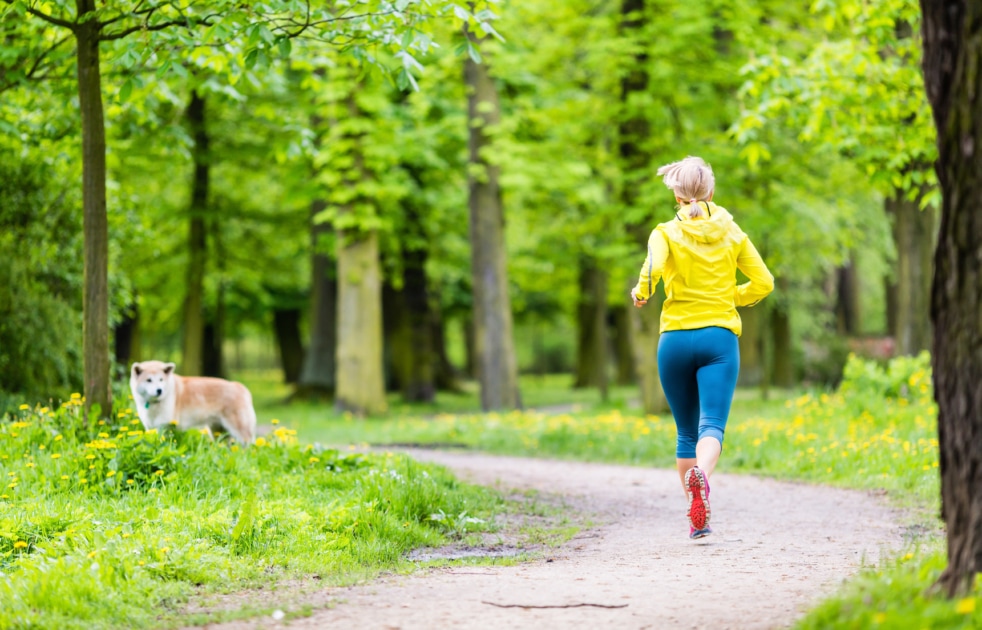What You Should Do If You Encounter An Aggressive Dog, And Other Safety Tips
These tips will help keep you safe, plus we offer expert advice on keeping your own dog out of trouble.

Encountering a vicious dog bearing fangs while you’re jogging, riding a bike or when your car breaks down can be frightening. There are things that you can do to avoid escalating the situation.
- Always stay alert. If you’re running with ear buds, remove one so you’re aware of your surroundings and can hear if danger is approaching.
- When approaching a yard with a barking or growling dog, cross the street and walk on the other side to avoid invading his territory.
- Never try to out run an aggressive dog in pursuit. It will only escalate the problem. Stay calm, and back away slowly.
- Instead of screaming, or yelling at the dog, speak to him in a soothing tone as you slowly back away.
- Don’t make direct eye contact. Staring in the eyes of an aggressive dog may prompt him to attack.
- If the dog gets too close or lunges at you, place a jacket, handbag or backpack, etc., between you and the dog. If the dog bites into the item, let him have it and take the opportunity to escape. If you’re riding a bicycle, place it between you and the dog for protection until you can get the dog owner’s attention or get yourself to safety.
- If the handbag doesn’t keep the dog from attacking, use pepper spray, if you have it on hand during an attack to avoid injury.
- If you do get bit, wash the wound with soap and water and seek immediate medical attention. The local authorities will need to contact the pet owner to determine if the dog has been vaccinated. Depending on local requirements, the biting dog may be held and observed for a couple of days to ensure that it doesn’t show signs of rabies.
How to Keep Your Dog Safe, Or From Biting or Harming Others
Walking your dog on a leash in public spaces is an important part of his training, yet it can be a stressful challenge when a variety of people and other pets are encountered along the way.
- Controlled behavioral training. Before taking your new pet or untrained dog into a busy park, help your dog practice healthy behavior within safe and controlled real life situations that you create with the help of a friend. Once your dog has successfully developed good social interaction with other people and pets in a controlled environment, and obeys basic commands, you’ll both be confident and comfortable venturing into public settings.
- Keep strangers at bay. When a stranger reaches out to pet your dog, if you’re unsure how your dog will react, take the safest response and ask them not to. If you have an overly friendly dog that likes to jump up on people, keep in mind that his sharp claws can also injure others. The elderly and small children are the most apt to encounter injuries from dogs. If your dog isn’t comfortable being approached by a stranger tell people that you’re training the dog, and to stay back. Put your palm up to visually say stop. When taking an untrained dog into a public setting, unwanted encounters from people can be largely avoided with the use of a “Dog in Training” vest. This visual prop serves as a yield sign, effectively sending the message to those nearby that your dog’s space is to be respected as you work with him in public settings.
- Walk between your pet and another dog. When a strange dog approaches as you’re walking, allow your anxious dog to change sides, to avoid a direct, stressful encounter.
- Proceed with extreme caution when it comes to vaccinating your pet. Holistic veterinarian, Dr. Karen Becker states, “Evidence is mounting that vaccines, in particular the rabies vaccine, are contributing to the problem of aggression in some dogs. The vaccine appears to bring on chronic rabies-like symptoms in affected dogs. Since rabies vaccines are required by law, insist on the 3-year vaccine and avoid the 1-year shot. Never re-vaccinate a dog who has had a reaction to a vaccine. I recommend you ask your holistic vet for the homeopathic rabies vaccine detox Lyssin after each rabies vaccine.”
Tips for Avoiding Dog Bites and Scratches
Aggression isn’t the only reason a dog may bite. Dogs react and bite out of fear, when challenged or startled.
- When approaching a dog from behind, make sure he hears you before reaching out to pet him.
- Don’t get in a strange dog’s face and smile. Bearing your teeth can be seen by a dog as a threat.
- Playing tug-of-war or wrestling with a dog can encourage aggressive behavior. Keep an eye on children as they play with dogs. A pull on a dog’s ear or rough housing could lead to a sudden, defensive bite or scratch.
- Teasing, such as taking a dog’s bone or toy should also be avoided.
- Pregnant or nursing dogs can be extremely protective and territorial. She may be more prone than normal to bite during these stages, so keep visitors at a safe distance.
- Don’t take your dog to highly-populated, loud events such as rock concerts, air shows or fireworks displays where he may behave aggressively out of fear. It’s best to just leave him at home.

Deborah Tukua
Deborah Tukua is a natural living, healthy lifestyle writer and author of 7 non-fiction books, including Pearls of Garden Wisdom: Time-Saving Tips and Techniques from a Country Home, Pearls of Country Wisdom: Hints from a Small Town on Keeping Garden and Home, and Naturally Sweet Blender Treats. Tukua has been a writer for the Farmers' Almanac since 2004.






I walk my dog and take the timeto introduce him to anyone asking. This way he is not afraid. I make him sit and stay before they pet him. Also at home he is traiined to be a lover not a fighter, so i am confident he will only attack if protecting.
Pet owners also need to realize, just because they love their pet does not mean everyone does. So keep the dog on a leash in public..like the beach or park. Clean up after them don’t allow them to defecate in others yards. People should be first priority, then the dog.
I walk my dog Chopper to the school bus stop every morning and let parents and children talk to and pet him. Now I am known as Mr. Chopper.
When barking dogs approach me while I’m riding my horse, I tell them what good dogs they are for protecting their property. I keep calm and keep praising them. So far, they’ve all walked away with their tails wagging! Might not work with a super aggressive dog!
Thanks for mentioning the vaccine issue. One of my dogs had severe reactions to vaccines every year. This led to early arthritis in the neck/shoulder area where they were administered. I was a vet nurse and believed general opinion that they were too important not to give. When I did quit giving them once arthritis kicked in, I was deemed a “bad” pet owner.
What the hell Farmer’s Almanac? Let’s bring the nutty anti vax craze to our animals. Surely a statement by a “holistic vet” is credible.
Very irresponsible of you.
Lots of good advice here for all dog owners, I wish we would all learn to ‘speak dog’. Thanks! One minor editorial comment: instead of “If you do get bit,” insert “If you are bitten,”